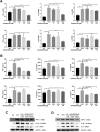Peptidome analysis of umbilical cord mesenchymal stem cell (hUC-MSC) conditioned medium from preterm and term infants
- PMID: 32967723
- PMCID: PMC7510303
- DOI: 10.1186/s13287-020-01931-0
Peptidome analysis of umbilical cord mesenchymal stem cell (hUC-MSC) conditioned medium from preterm and term infants
Abstract
Background: The therapeutic role of mesenchymal stem cells (MSCs) has been widely confirmed in several animal models of premature infant diseases. Micromolecule peptides have shown promise for the treatment of premature infant diseases. However, the potential role of peptides secreted from MSCs has not been studied. The purpose of this study is to help to broaden the knowledge of the hUC-MSC secretome at the peptide level through peptidomic profile analysis.
Methods: We used tandem mass tag (TMT) labeling technology followed by tandem mass spectrometry to compare the peptidomic profile of preterm and term umbilical cord MSC (hUC-MSC) conditioned medium (CM). Gene Ontology (GO) enrichment analysis and ingenuity pathway analysis (IPA) were conducted to explore the differentially expressed peptides by predicting the functions of their precursor proteins. To evaluate the effect of candidate peptides on human lung epithelial cells stimulated by hydrogen peroxide (H2O2), quantitative real-time PCR (qRT-PCR), western blot analysis, and enzyme-linked immunosorbent assay (ELISA) were, respectively, adopted to detect inflammatory cytokines (TNF-α, IL-1β, and IL-6) expression levels at the mRNA and protein levels.
Results: A total of 131 peptides derived from 106 precursor proteins were differentially expressed in the preterm hUC-MSC CM compared with the term group, comprising 37 upregulated peptides and 94 downregulated peptides. Bioinformatics analysis showed that these differentially expressed peptides may be associated with developmental disorders, inflammatory response, and organismal injury. We also found that peptides 7118TGAKIKLVGT7127 derived from MUC19 and 508AAAAGPANVH517 derived from SIX5 reduced the expression levels of TNF-α, IL-1β, and IL-6 in H2O2-treated human lung epithelial cells.
Conclusions: In summary, this study provides further secretomics information on hUC-MSCs and provides a series of peptides that might have antiinflammatory effects on pulmonary epithelial cells and contribute to the prevention and treatment of respiratory diseases in premature infants.
Keywords: Infant diseases; LC-MS/MS; Peptidomics; TMT labeling; hUC-MSCs.
Conflict of interest statement
The authors declare that they have no competing interests.
Figures





References
-
- Blencowe H, Cousens S, Oestergaard MZ, Chou D, Moller AB, Narwal R, et al. National, regional, and worldwide estimates of preterm birth rates in the year 2010 with time trends since 1990 for selected countries: a systematic analysis and implications. Lancet. 2012;379:2162–2172. doi: 10.1016/S0140-6736(12)60820-4. - DOI - PubMed
Publication types
MeSH terms
Substances
LinkOut - more resources
Full Text Sources

